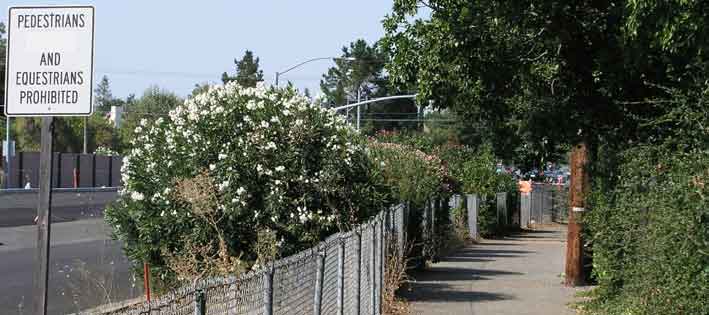
Expressways in Santa Clara County are not freeways, as previously claimed by County highway staff. They are arterial roads, as has finally been recognized by the County Expressway Master Plan. Most have 45 mph speed limits, and range from 35 to 50 mph. This is within the speed limit range of arterial roads -- which can be up to 55 mph -- such as Monterey Road in San Jose. Expressways were mostly existing roads with a name change to expressway in the 1960s and 1970s, when they added paved shoulders that were a great improvement for bicyclists and pedestrians. Non-motorists were often banned even with no change in the speed limit (e.g., 45 mph on Capitol Avenue).
All cities repealed all bicycle bans (1980-1991) on expressways and most cities repealed pedestrian bans (1982-2003). Logic and truth won out over the scare tactics used by County highway staff and many city staffs, who had taken to posting of "bicycles and pedestrians prohibited" signs -- often illegally -- as a cheap alternative to relocating bicycle and pedestrian facilities when adding more traffic lanes.
The San Jose ordinance makes no exception for pedestrian use of sidewalks, pedestrian paths, wide shoulders and bus stops along expressways and has a clause that requires posting of "pedestrians prohibited" signs even for these facilities. Despite that, two expressways (Almaden and Montague) never had "pedestrians prohibited" signs. Neither did Southwest which is a "city expressway." Neither do any of the regular arterial roads having the same speed limits. At our efforts, Capitol (in 1997) and Lawrence (in 2003) had "pedestrians prohibited" signs removed, at least on one side. Both have sidewalks today.
Today, only San Tomas has "pedestrians prohibited" signs on both sides of the road in San Jose. This is despite the fact it has excellent pedestrian paths most of the way. [See photos and maps of San Tomas.] In addition, it also has wide shoulders -- usually 9 feet wide -- which are recognized to be safe for pedestrians by the County Expressway Master Plan. To encourage pedestrians and transit use, compliance is needed with the Board order to create pedestrian paths along San Tomas, which has 12 feet, typically, between the curb and the property line. That is plenty of room, considering most sidewalks are 5 feet wide, and a path can be 2 or 3 feet wide. The length of San Tomas in San Jose is 1.75 miles. (The only other expressway with "pedestrians prohibited" signs on both sides is not in San Jose. It is Foothill in north County.)
In 1989, the San Jose City Council unanimously repealed the bicycle prohibition on all expressways despite vigorous -- and vicious -- opposition by its traffic engineering and city staff. [Details in Despite Unanimous San Jose City Council Vote, the Struggle was Not Over]. At the same time, the ordinance was brought into compliance with State law, and pedestrians were allowed on 4 of the 6 expressways by the revised ordinance, while still being prohibited on the two with the best pedestrian facilities (San Tomas and Lawrence). [See why this came about.]
The San Jose prohibitory ordinance contradicts recent policies of VTA, the County Supervisors, FHWA, Caltrans, Vehicle Code 21949, and State Legislative Resolution ACR 211. The ordinance discourages walking and transit use by forcing large walking detours. The ordinance increases danger because these detours force crossings of many extra intersections, where most pedestrian crashes occur. It needs a prompt repeal.
The Modern Transit Society has successfully fought for pedestrian safety on expressways since 1982, had a major influence on County policy, and has successfully fought for removal of pedestrian prohibitions as shown in the Timeline.
The fundamental problem
Why are expressways "express?"
Why did usually the expressways with the best pedestrian facilities prohibit pedestrians, but not the others?
Pedestrians on shoulders: examples
Why were pedestrians and bicycles originally prohibited?
Why County highway engineers opposed pedestrian use of shoulders and paths under all conditions.
Pedestrians are already allowed on most expressway shoulders and most expressway miles
Comparison where pedestrians walk
Pedestrians' right to use the roadways and State law regarding prohibitions
Expressway intersections: pedestrians are already allowed
Safety
Montague Expressway: Request to create paths where shoulders were eliminated
Extremely low cost safety improvement for intersections
Liability
Effect on transit and the environment
Prohibitory ordinances have affected roadway designs and are very damaging to pedestrians
Prohibitory signs themselves increase danger and cause additional
problems
Are expressway shoulders wide enough for pedestrians?
The Appendices are located in separate web pages. Click the topic(s) below.
San Tomas photos and
official pedestrian-expressway map of San Tomas.
Map showing
detours needed to avoid walking along Capitol Expressway
Sidewalks Prohibited!
(photos from 1997)
"PED ONLY" lane on Hwy. 190; pedestrians on shoulders
of urban state highways.
Despite Unanimous San Jose City Council Vote, the
Struggle was Not Over
San Jose Municipal Code #11.32.070
Legality of Pedestrian Prohibitions, Legal
Opinion of County Counsel
Liability of City or County, Legal Opinion of County
Counsel
Jurisdiction of Cities versus County, Legal Opinion
of County Counsel
Approved Aug. 19, 2003: County Supervisors Policy:
The Pedestrian Element of the Comprehensive
County Expressway Planning Study.
Approved Nov. 7, 2002: VTA policy
(Santa Clara County Transportation Authority)
Recent: FHWA policy
Recent: State Legislative Resolution, ACR
211
Recent: California State law,
Vehicle Code 21949
Presentation for repeal (4 MB pdf file) to San Jose BPAC (Bicycle Pedestrian Advisory Committee) (10/10/06)
County Roads attempts new pedestrian bans in San Jose (10/10/06)
Expressway topics and links
Sidewalks Prohibited ! (Capitol Expressway historical web page)
Prior to the 1950’s, the street pattern was laid out in a rectangular grid pattern. If a street was blocked for construction or other reason, the pedestrians merely had to walk one block, and then proceed on their way. After this period, the streets were laid out in winding, random and intermittent street patterns. The purpose of this was to discourage cars from traveling on secondary streets and encourage them to use arterials, including expressways (a type of arterial road). The effect that a detour designed for the car user has on pedestrians and transit patrons was never considered. A detour designed to take a car user an extra 2 minutes for choosing to travel on secondary streets is equivalent to a 20 minute detour for pedestrians and transit patrons!
 versus
versus 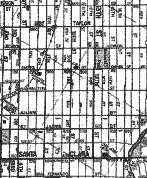
The above maps illustrate the difference between hierarchical and traditional street patterns. Pedestrians, bicyclists and auto users who desire to go westward from the residential development (at center of Hierarchical map) must first wind their way eastward to leave the development, exiting on the collector (Main. St., Milpitas), then proceed south to the arterial (Montague Expressway) before being able to proceed westward. In contrast, there are many streets to choose from in all directions in this traditional pattern of an old San Jose neighborhood.
Prohibiting pedestrians from expressways means major travel disruptions for them (there seldom is a nearby alternative), discouraging walking and transit use. As an example, see the map showing detours needed to avoid walking along Capitol Expressway.
Recent VTA policy acknowledges the points made in this section, and that pedestrians are forced onto expressways.

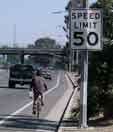
The speed limits are 50 mph yet pedestrians walk on shoulders. They are not "expressways" but regular arterials in San Jose, Trimble Road (left) and Monterey Road (right).
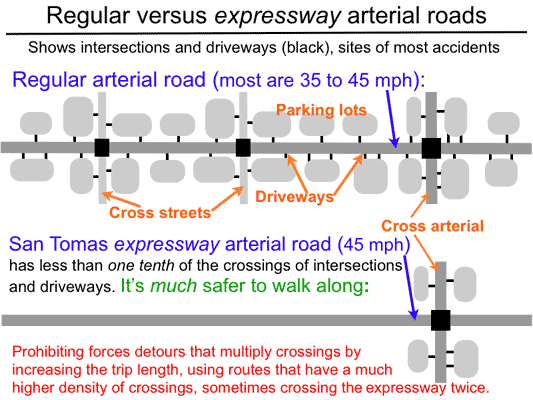
Expressways are arterial roads that have few intersections (1/5 as many, on average, for the same distance), almost no driveways, and no parked cars. These three attributes make the expressways the safest roads to walk and bicycle. These attributes also make them "express," decreasing travel times without increasing speeds.
By analogy, express trains are "express" not because they have a higher top speed than local trains, but because they make fewer stops. Buses that are "express" observe the same speed limit as regular buses.
Speeds of expressways are no greater than for regular arterials. Most expressways are 45 mph, yet are outnumbered by regular arterials of the same speed limit within the County. The two expressways with the highest speeds, 50 mph, are not unique, either, as two arterials in San Jose (Trimble and Monterey) are also 50 mph. Both have shoulders for pedestrian use, in portions.
Speed limits are not the reason for prohibiting pedestrians, either from regular arterials or from "expressway" arterials. Both the 50 mph expressways, Lawrence and Central, already allow pedestrians almost everywhere except that San Jose prohibits use of the existing sidewalks. Pedestrians are allowed to use shoulders of 50 mph Central Expressway by Santa Clara, Mountain View, Palo Alto and (in 2003) Sunnyvale. (On Lawrence, sidewalks were constructed in Santa Clara and Sunnyvale by MTS' efforts after shoulders, used by pedestrians, were eliminated for lane additions. Shoulders were subsequently restored for bicycles.)
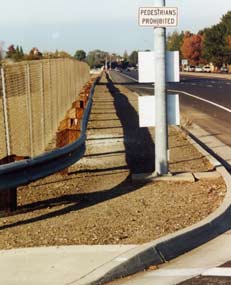 The reason why the remaining "pedestrians prohibited" signs exist on certain expressways, but not on most, is historical.
The San Jose ordinance does not consider safety of pedestrians whatsoever. It uses "right of access," not
what pedestrian facilities, if any, exist, in declaring which expressways are prohibited to pedestrians.
The reason why the remaining "pedestrians prohibited" signs exist on certain expressways, but not on most, is historical.
The San Jose ordinance does not consider safety of pedestrians whatsoever. It uses "right of access," not
what pedestrian facilities, if any, exist, in declaring which expressways are prohibited to pedestrians.
Where the expressway was formerly an orchard, it often means the expressway has more room for sidewalks and wider shoulders. In San Jose, it's San Tomas and Lawrence**. Despite being safer, the highway engineers were able to prohibit pedestrians and bicycles in former orchards through a quirk in State law. Details: State law only enabled prohibiting from freeways and only if the right of access were acquired from all abutting property owners --a contract whereby the property owner agrees never to go onto the "freeway" from his property. Acquiring the right of access is easy by purchasing orchards. They then claimed that each block of the road is a separate and distinct "freeway" from every other block. While this sounds absurd, it was a legal loophole.
Photo: San Tomas & Payne in San Jose with "Pedestrians Prohibited" sign prohibiting use of the pedestrian path.
However, most "expressways" were regular roads with a name change. Even if squeezed by lane additions (e.g., Montague), pedestrians and bicycles could not be banned by State law. [more info] Some, such as Montague or Almaden, never had "pedestrians prohibited" signs. If these former roads did have prohibitory signs, then the signs were illegal, and MTS and the Silicon Valley Bicycle Coalition (SVBC) forced their removal.
Furthermore, MTS and SVBC also convinced most City Councils to repeal prohibitory ordinances even where they could be banned.
** Lawrence in San Jose was on former orchards, but Lawrence north of Stevens Creek Blvd. (in Santa Clara and Sunnyvale) was formerly Lawrence Station Road. Today, we have sidewalks and shoulders for bicycles there only because pedestrians and bicycles became "allowed" by MTS and SVBC forcing signs to be removed. In San Jose, "Pedestrians prohibited" signs on Lawrence were removed directly above sidewalks (which are on one side since original construction) in early 2003, but prohibitory signs on the other side of the road remain and need removal, to achieve compliance with the County Expressway Master Plan, to not force pedestrians to cross the expressway twice if they don't need to, and to not mislead motorists to not watch out for slow walkers crossing the wide road. on Lawrence in San Jose both by signage and by ordinance.
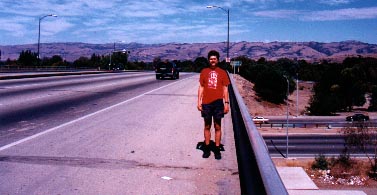 Photo, right: Pedestrians frequently use the Capitol
Expressway overpass near the Capitol Flea Market. The
alternative to using the shoulder above is to cross the
railroad tracks at-grade, then cross Monterey Highway at grade,
and add a two-mile walking detour [see
map] with about 40 minutes added to the trip. It should be obvious that crossing Monterey Highway at-grade is much more dangerous than
using a bridge. What is not obvious is that the act of forcing a detour requires crossing many additional intersections.
This greatly increases danger because
intersections and crossings are where the vast majority of pedestrian - car accidents occur.
After years of stonewalling on removal of "pedestrians prohibited"
signs on the 11-foot shoulders by both San Jose staff
and County highway engineers, MTS
forced them to remove the signs in 1997 [more photos.]. The signs violated
both City Ordinance and
State law. (A higher fence and a sidewalk were constructed in 2002 because a pedestrian was killed crossing at-grade,
next to the bridge, instead of using the bridge to cross, according to Dan Collen of R&A Dept.) Speed limit is 45 mph.
Photo, right: Pedestrians frequently use the Capitol
Expressway overpass near the Capitol Flea Market. The
alternative to using the shoulder above is to cross the
railroad tracks at-grade, then cross Monterey Highway at grade,
and add a two-mile walking detour [see
map] with about 40 minutes added to the trip. It should be obvious that crossing Monterey Highway at-grade is much more dangerous than
using a bridge. What is not obvious is that the act of forcing a detour requires crossing many additional intersections.
This greatly increases danger because
intersections and crossings are where the vast majority of pedestrian - car accidents occur.
After years of stonewalling on removal of "pedestrians prohibited"
signs on the 11-foot shoulders by both San Jose staff
and County highway engineers, MTS
forced them to remove the signs in 1997 [more photos.]. The signs violated
both City Ordinance and
State law. (A higher fence and a sidewalk were constructed in 2002 because a pedestrian was killed crossing at-grade,
next to the bridge, instead of using the bridge to cross, according to Dan Collen of R&A Dept.) Speed limit is 45 mph.
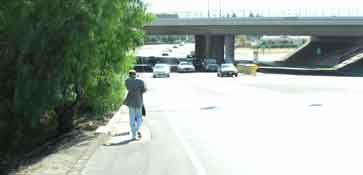 Photo, next: It is important to keep the perspective that most shoulder use is not on "expressways," but regular arterials.
Man -- "going to catch a light rail," he said -- has to walk on the shoulder of Curtner Ave.
to reach the LRT station on the bridge (shown). Speed limit was 45 mph, now 40 mph.
Photo, next: It is important to keep the perspective that most shoulder use is not on "expressways," but regular arterials.
Man -- "going to catch a light rail," he said -- has to walk on the shoulder of Curtner Ave.
to reach the LRT station on the bridge (shown). Speed limit was 45 mph, now 40 mph.
More photos: Not only do pedestrians use shoulders on many City streets and County expressways, Caltrans highway engineers have no problem with pedestrian use of shoulders even in an urban area. [See photos.]
[Due to length, this section was moved to a separate web page. It answers the question and is also a history of the prohibitions.]
Today, 93% of expressway miles in San Jose allow pedestrians when looking at "pedestrians prohibited" signs, at least on one side of the road. (The ordinance prohibits much more, but is not enforceable without posting such signs.) Mostly, pedestrians walk on the shoulders, which are usually wide is enough for a parked car. Both San Jose (in 1989) and the County (also in 1989) adopted policy requiring shoulders on all expressways (both as a result of MTS' efforts).
Expressway miles open to peds. miles closed to peds. total miles status needs Almaden 8.2 0 8.2 sidewalk, shoulder, peds allowed none Montague 2.9 0 2.9 shoulder most places, few sidewalks, lacks some
shoulders, peds allowed Conform with SJ and SCC policies requiring shoulders
and/or build paths. Capital 9.2 0 9.2 sidewalk, path/shoulder, a few illegal signs remain remove all remaining signs Southwest 2.0 0 2.0 sidewalk, path/shoulder, peds allowed none Lawrence 2.2 0 2.2 sidewalk on one side, peds "prohibited" remove all remaining signs San Tomas 0 1.8 1.8 shoulder or path, peds "prohibited" remove signs Total miles 24.5 1.8 26.3 % open % closed % total Percentage 93 7 100
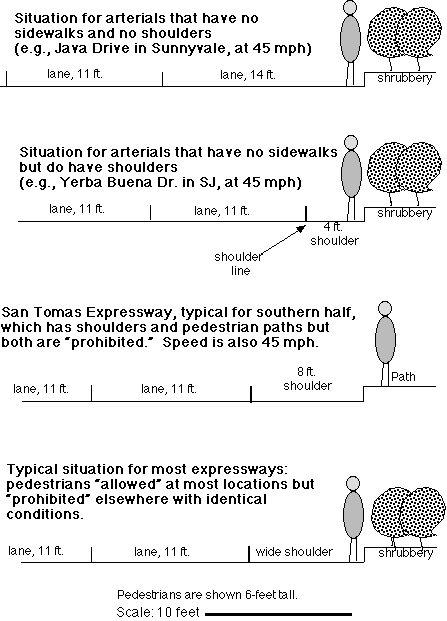
Expressway intersections, like arterial intersections, are the most dangerous part of the roadway because most accidents occur there. Pedestrians are already allowed at all intersections, so “dangerous intersections” cannot be an excuse to ban pedestrians from walking along the shoulders. Intersections must be made safer as shown below in Extremely low cost safety improvement for intersections.
Prohibiting pedestrians (which includes transit patrons) from expressways would actually increase the danger to pedestrians because:
The above factors have the most effect on increasing danger. Three more factors are:
Also see how prohibitory signs themselves increase danger.
Pedestrians have always been allowed on Montague. Despite that fact, shoulders were eliminated in portions of eastern Montague when adding lanes in 1989, usually to add right-turn-only and "acceleration" lanes, creating unsafe conditions for pedestrian. All prior requests by MTS to the County highway engineers to restore shoulders or create paths were ignored.
Pedestrian use on eastern Montague will increase with the LRT extension now under construction. As usual, there is no parallel route.
The highway engineers need to create a path where they eliminated the shoulder (or else restore the shoulder, but this is less likely.) Paths need to be on both sides of the road if both shoulders were eliminated. The above work should be combined with making intersections safe for pedestrians (as described below). Embankments, created for the glimpsing of motorists, need to have paths constructed using trail-building methods of the County Parks Dept. The work would be much easier than in a park because there are no large rocks or roots to be dug out, and there is easy access from the road.
While costs of path/trail building would be fairly small, the funds need to come from the same budget which created the additional lanes for motorists, or road funds in general, and not from TDA or other pedestrian funds. The shoulders are legitimate and legal pedestrian facilities under State law where no adjacent sidewalk exists. Shoulders were paid for by property taxes. They were eliminated for lane additions which only benefit motorists.
This request to restore pedestrian safety is being made, once again, to the County. It is included here to show the double standard that exists on expressways regarding the pedestrian prohibitions. Safety has nothing to do with whether or not pedestrians are prohibited. Politics does.
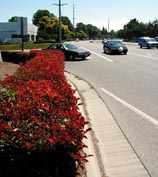
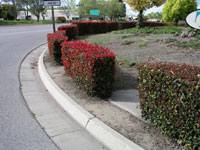 Photos: After many years of ignoring MTS' repeated requests, the County opened gaps in the shrubbery in March 2003 [near right] so
pedestrians can walk through the shrubbery
instead of in the travelway of a right turning motorist going around the blind curve [far right]. [Montague Expressway, Milpitas.]
Photos: After many years of ignoring MTS' repeated requests, the County opened gaps in the shrubbery in March 2003 [near right] so
pedestrians can walk through the shrubbery
instead of in the travelway of a right turning motorist going around the blind curve [far right]. [Montague Expressway, Milpitas.]
A motorist turning right from an arterial onto an expressway actually looks left or even backwards, as the car is moving forward. This presents a danger to pedestrians which MTS first pointed out in the 1980s. The problem is easily solved by trimming shrubbery as shown on the diagrams below.
The County Expressway Plan (adopted in 2003, page 93) states: "Landscaping needs to be kept trimmed back at intersection areas and along the travel way so pedestrians do not have to enter the travel lane." As a result of an MTS request, the County Board of Supervisors enacted basically the same policy in 1991 (8/13/91). Lamentably, the traffic engineers have not complied, and this has resulted in the death of a pedestrian in June, 1992. The accident occurred at a driveway designed like an intersection. The pedestrian could not have been prohibited because a driveway is proof that the road is not a freeway, under Vehicle Code #21960. The shrubbery must be cut back as per County policy at intersections and driveways where such hazard exists as soon as possible. See illustration below.
Such action is separate from the repeal of prohibitions, since pedestrians are forced to, and do, walk past “pedestrian prohibited” signs by the lack of any alternative, including where the accident occurred. This issue is not related to whether pedestrians are or are not prohibited (they use the expressway regardless), but whether the road will be made safe for pedestrians.
Fortunately, bus stops have eliminated the risk at two corners of most intersections. The bus stops are located at the "far" corners, which are the riskier (by a factor of 3) due to right-turn-on-red merging onto the expressway. Clearly, an audit must be done followed by work orders. Once shrubbery is trimmed, pedestrians walking there would usually keep plants from overgrowing the path.
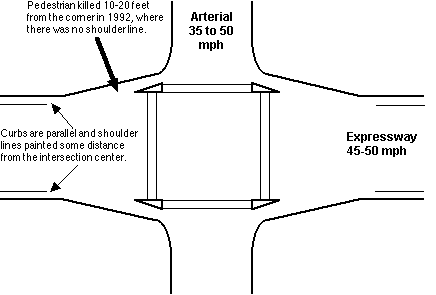
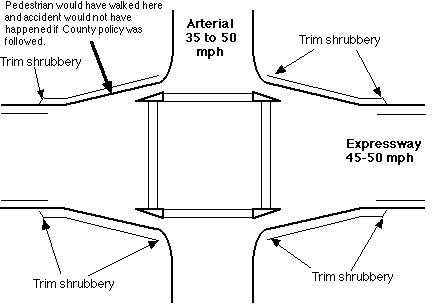
In the late 1980s, the Modern Transit Society (MTS) requested the Santa Clara County Transportation Agency (now superseded, it included roadway design) to implement the policy shown. MTS never even got a reply until we went to the County Supervisors. The Supervisors adopted the policy in 1991, but the County highway engineers have refused to implement the policy (except on Lawrence Expressway) to this day through the tactic of endless stonewalling. MTS even made detailed lists of locations where trimming was needed, but was ignored (except on Lawrence Expressway as a result of Scotty Bruce heading the Department for a short period). Allen Jones, manager of Road Operations, stated that he refuses because that would "encourage pedestrians to violate the signs." This was despite the fact the signs were proven illegal (in both prior and the subsequent County legal opinions), and that signs have never eliminated pedestrians due to lack of any alternative.
After the death of the pedestrian which was caused by their failure to comply, County highway engineers repeatedly used that incident as an exemplary reason for prohibiting pedestrians from all expressways (excepting sidewalks) when fighting the repeal of pedestrian prohibitions, including before the VTA BPAC.
Here is an old diagram from MTS which shows tapered shoulders that were the norm at the time when bicycles were still "prohibited" from many, but never all, expressways. It also shows that at most intersections, the act of building bus stop facilities automatically fulfilled the policy at half the corners.
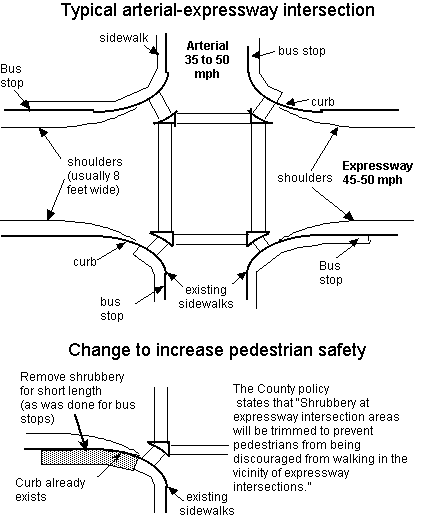
The liability of bicycles on expressways has been thoroughly discussed by attorneys from various cities, and all are in agreement. (The same liability laws apply to both pedestrians and bicycles.) Sunnyvale City Attorney Louis Green states “... there appears to be minimal, if any, potential liability to the City, especially in light of the questions raised by County Counsel concerning the ability of the City to regulate.” [opinion of May 19, 1987, page 7]. Santa Clara County Counsel agrees in his Legal Opinion dated Feb. 13, 1989. The City Attorney of the City of Santa Clara answers succinctly to the question “Would there be City liability to allow bicyclists on the expressway?” by the answer “Nominal, if any.” [opinion of Sept. 4, 1987, page 5].
If the prohibition of pedestrians is not repealed, it would have the following consequences:
1) Transit patrons would be forced to take lengthy detours that
discourage transit usage. A one-mile detour on foot increases
total commute or trip time by approximately 20 minutes if they indeed
took the detour. However, pedestrians do realize the lack of logic
and discrimination of the prohibitions, and many just walk past the
signs.
2) People would be prohibited from taking transit if employed
by businesses located on the expressways.
3) Such conditions are contrary to County policies that
purport to discourage auto commuting and encourage the use of other
travel modes. The County’s T2010 General Plan has stated that
the lack of pedestrian access is a major problem in this regard.
4) Item from 1992: A California appellate court ruled that the
Metropolitan Transportation Commission was violating the Clean Air
Act in permitting certain road “improvements” to go
forward, largely because such changes tend to promote additional auto
use. It is imperative, therefore, that use of non-polluting forms of
transportation, such as pedestrian travel, be allowed (and
encouraged!).
5) It would violate the new Caltrans policy which states
[quoted from Spinning
Crank, 5/01]: ... fully consider the needs of non-motorized
travelers (including pedestrians, bicyclists and persons with
disabilities) in all programming, planning maintenance, construction,
operations and project development activities and products.
The city ordinances prohibiting pedestrians on expressways have been very damaging to pedestrians. The County highway engineers point to these ordinance as the reason they won't construct sidewalks when adding lanes. In San Jose, the situation is even worse because even if pedestrians are allowed, the highway engineers interpret the Ordinance any way they please because it is so vaguely written, and because San Jose staff has refused to tell the County highway engineers in years past where the prohibitions apply (despite my efforts, through the process of endless stonewalling). The highway engineers know full well exactly where pedestrians are allowed because MTS and SVBC have repeatedly forced them to remove illegal signs over the years, sometimes from the same locations.
The highway engineers simply don't want to use part of the money in the lane-additions budget for relocating pedestrian facilities (from wide shoulders to sidewalks). The ordinances are a convenient excuse to do just that. Three cases in San Jose illustrate the point.
The next example is in Campbell on the part of San Tomas that was formerly Camden Ave. All transportation modes were and are allowed, and formerly even included a streetcar line. Yet, pedestrians were forced to walk in the traffic lane for 18 years after highway engineers changed shoulders to lanes in 1982:
Lane-addition projects should include and pay for relocating pedestrian facilities, instead of:
1) the unsafe practice of changing pedestrian facilities to traffic lanes and exposing pedestrians to danger for years until pedestrian funding is finally obtained to build sidewalks, or2) the undesirable practice of reducing shoulder width to narrow (4-5 feet) where pedestrians walk, although this is still safe as evidenced by roadway design practice on some city streets and on some expressways.
The ordinances are just a convenient pretext to do (1) or (2) above, which is the real reason for keeping prohibitions today. The first step in solving this problem is repeal of prohibitory ordinances. Sidewalks can be required as a condition of lane addition, but historically, sidewalk construction has occurred as a result of allowing pedestrians, and did not occur where pedestrians were prohibited.
The VTA Bicycle & Pedestrian Advisory Committee, at it's meeting of May 8, 2002 [minutes are on VTA's website and on MTS' website]:
"Recommended that all pedestrian prohibition signs be removed from the expressways."
"Recommended that legal issues be investigated regarding hurdles that need to be overcome."
"Recommended removal of all equestrian prohibition signs."
Why remove "Equestrians Prohibited" signs? All cities already have a general ban on horses on public roads in their jurisdiction. That includes expressways. It is not logical to post these signs unless such signs are also posted on other streets also.
The "Pedestrians And Equestrians Prohibited" signs (example at top of page):
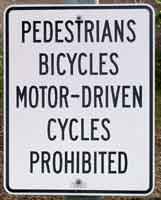 look
like signs at freeway entrances (shown at right), giving the false impression
to motorists that the road is a freeway instead of a 45 or 50 mph arterial
road. In fact, the signs are only allowed on freeways by
California Vehicle Code sections 21960
and 21. [Other
parts of the code allow these signs on toll roads, tunnels and major bridges,
but in the Bay Area, the first does not exist and the other two, where signs
occur, are all on freeways.]
look
like signs at freeway entrances (shown at right), giving the false impression
to motorists that the road is a freeway instead of a 45 or 50 mph arterial
road. In fact, the signs are only allowed on freeways by
California Vehicle Code sections 21960
and 21. [Other
parts of the code allow these signs on toll roads, tunnels and major bridges,
but in the Bay Area, the first does not exist and the other two, where signs
occur, are all on freeways.]Prohibitory signs with sidewalks
A simple study will reveal that if a sidewalk exists on only one side, the majority of pedestrians will use it instead of the shoulder on the other side. Yet, statistically, walking on the shoulder for one block is much safer than crossing the expressway twice just to use the sidewalk on the other side. Therefore, posting prohibitory signs where a sidewalk exists just on one side is not only unnecessary, it is harmful to those choosing to avoid crossing the expressway twice.
At some expressway locations, the"Pedestrians And Equestrians Prohibited" signs remain on one side of the road even where there is a sidewalk on the other side of the road. The signs apply to the entire roadway, and effectively "prohibit" use of the sidewalk on the other side. It occurs very commonly on Lawrence Expressway in San Jose (but not in Santa Clara where all signs on Lawrence were removed despite a sidewalk being only on one side). This is illogical and needs correction, since it occurred due to historical, not logical, reasons detailed here:
Previously, two large [example] prohibitory signs per intersection were posted on expressways that had prohibitory signs. As a result of MTS requesting illegal sign removal on Central Expressway in 1989, the County highway engineers doubled all the signs to four per intersection, and not just on Central Expressway, but on all expressways that had prohibitory signs. Even where sidewalks existed (e.g., Lawrence in San Jose) each end of every sidewalk thereafter had a sign prohibiting sidewalk use. Later in 1989, MTS forced them to remove all illegal signs on Central Expressway, both the new ones and the old ones, so it appears the entire exercise was to demostrate the highway engineers' historic animosity towards pedestrians.

Photo: Sidewalk is not visible. This on-ramp (northbound) to Lawrence Expressway at Stevens Creek is not pedestrian friendly. All prohibitory signs were removed years ago. But there is a sidewalk, it's just not visible from here.

Photo: Here is the sidewalk, on the other side of the bridge (off-ramp of southbound traffic). The solution is NOT to ban pedestrians by posting "pedestrians prohibited" signs, but to guide them to the sidewalk with guide signs.
The County Expressway Master Plan [San Tomas section, page 8, and other sections] mentions "directional signage to parallel pedestrian facilities" and Caltans provides specifications for guide signs. There are no guide signs today because discouraging pedestrians -- whether explicitely by posting "pedestrians prohibited" signs or by an unfriendly roadway design -- was the County highway engineer's practice in the past. The background color --green-- is the standard for "bike route" and other "guide signs" stipulated by Caltrans. MTS has created guide signs (examples below) as mask files that can used for creating the signs --available upon request.
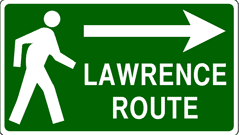
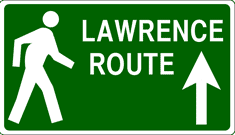
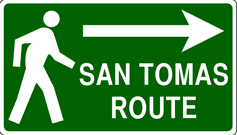
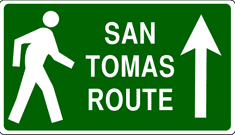
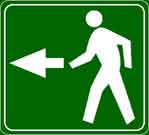
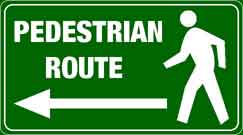
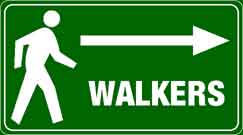
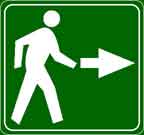
Walkers should not be recommended to do an at-grade crossing of 5 to 10 lanes except where the "wide shoulder" specification of the County Expressway Master Plan is not met and a 2-foot wide dirt path is not achievable by shrubbery trimming. This is because walking along a wide shoulder or a path is much safer than crossing a wide road. "Wide shoulder" specifications are met by compliance with existing "bike lane" requirements of the Master Plan and Vehicle Code section 21966 that allows walking in a bike lane where adjacent sidewalks are lacking.
Examples of not visible sidewalks are Lawrence at Stevens Creek (including above photos but also continuing south) and Foothill Expressway at Grant (SW corner). Examples of a nearby pleasant parallel route is the residential Blazingwood Drive in Sunnyvale that parallels Lawrence Expressway by about 100 feet -- a rare situation due to the hierarchical street network. Walkers actually prefer it -- it's more pleasant. It would be more productive to point the way with a sign rather than to ban or discourage walkers with the currently posted "pedestrians prohibited" signs.
This question is now answered by the County Expressway Master Plan (approved 8/19/03). It is a more powerful statement than the logical arguments below, so this section can now be skipped.
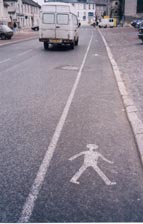
In contrast, the narrowest shoulders (4 feet wide) are found on some regular arterials and on sections of expressways that have always allowed pedestrians (portions of Almaden and Montague). These expressways had wide shoulders originally, but traffic engineers reduced the width when adding even more lanes for automobiles. Even a sidewalk on Montague was destroyed (in San Jose), thus forcing people to walk on 4-foot shoulders (formerly, 8 feet wide and used by bicyclists).
Photo, right: Shoulder for pedestrians, or "pedlane," clearly indicats use. Chantilly, France.
Obviously, the highway/traffic engineers view narrow shoulders as safe. Yet, most have opposed both bicycle and pedestrian use of "expressway" shoulders, and their most effective tactic was false safety arguments, but their actions contradict their words.
While County highway engineers previously claimed a conflict of bicyclists versus pedestrians as another argument to prohibit pedestrians from shoulders, nothing can be further from the truth --from my 30 years of bicycling on expressways (and the VTA BPAC agreed by their vote to remove all prohibitory signs.) Some expressways have shoulders designated as bicycle lanes. Yet, Vehicle Code #21966 allows pedestrians in the bicycle lane where there is no "adjacent adequate pedestrian facility." In the worst case of a narrow shoulder, bicyclists would treat the pedestrian no different than a parked car on any other road with the same speed limit: by going around it when there is a break in the traffic flow.